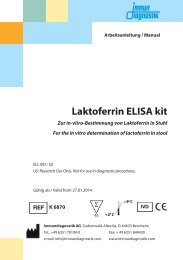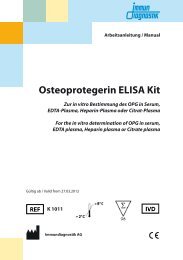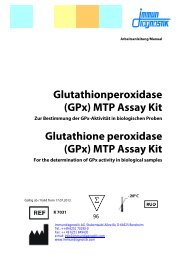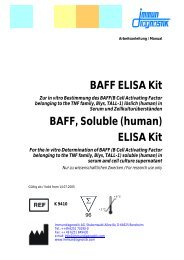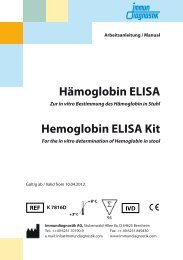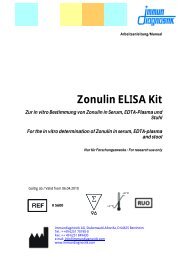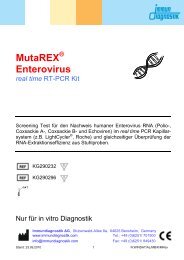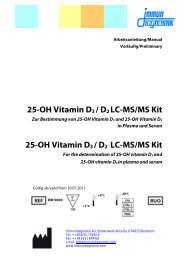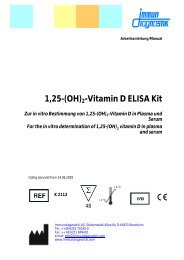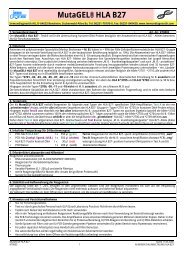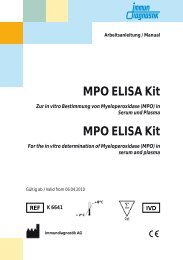Vitamin A/E HPLC Kit - Labodia
Vitamin A/E HPLC Kit - Labodia
Vitamin A/E HPLC Kit - Labodia
Erfolgreiche ePaper selbst erstellen
Machen Sie aus Ihren PDF Publikationen ein blätterbares Flipbook mit unserer einzigartigen Google optimierten e-Paper Software.
<strong>HPLC</strong>-Analytik / <strong>HPLC</strong> analytics <strong>Vitamin</strong> A/E<br />
1. INTENDED USE<br />
The Immundiagnostik Assay is intended for the quantitative determination of <strong>Vitamin</strong> A/E in<br />
serum and plasma. This Assay is designed for in vitro diagnostic use only.<br />
2. INTRODUCTION<br />
<strong>Vitamin</strong> A (Retinol) and <strong>Vitamin</strong> E (Tocopherol) are fat-soluble vitamins, which could be stored<br />
for longer periods in the adipose tissue. Both, lack and excess could express in complaints.<br />
<strong>Vitamin</strong> A is essential for the visual process and recovers the skin and mucosa. A lack of<br />
<strong>Vitamin</strong> A will reduce the visual power up to total blindness. An excess of <strong>Vitamin</strong> A could<br />
cause headache, damage of the skin, liver disease, painful alteration in the skeleton or foetal<br />
damage.<br />
<strong>Vitamin</strong> E (Tocopherol) is an antioxidant and protects unsaturated fatty acids against<br />
oxidation. It also protects the cells of the body by catching radicals.<br />
A lack of vitamin E in animal experiments demonstrates diseases of muscle, nervous system,<br />
heart, liver and reproduction system. These symptoms were not observed in humans. <strong>Vitamin</strong><br />
E can be stored in the adipose tissue in large amounts. A lack can be caused by a malfunction<br />
in digestion or resorption of fatty acids.<br />
3. PRINCIPLE OF THE TEST<br />
The first step in the determination of <strong>Vitamin</strong> A and E includes the sample preparation. In the<br />
first step an internal standard solution is added. During the precipitation higher molecular<br />
substances are removed. After centrifugation the supernatant is used for injection into the<br />
<strong>HPLC</strong> system.<br />
The separation via <strong>HPLC</strong> follows an isocratic method at 30°C using a „reversed phase“ column;<br />
one run lasts 15 minutes. The detection is performed by an UV detector at two different wavelengths<br />
(<strong>Vitamin</strong> A: 325 nm; <strong>Vitamin</strong> E: 300 nm). The quantification is performed with the delivered<br />
standard solution; the concentration is calculated via integration of the peak areas in the<br />
internal standard calibration mode.<br />
15



